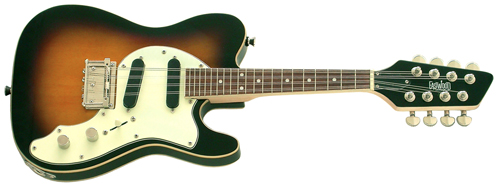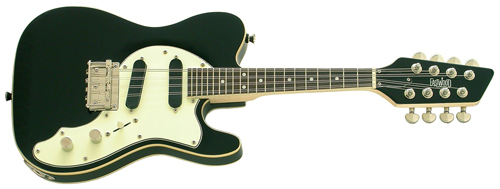
Eastwood Mandocaster Electric Mandolin (Antique Sunburst)
BACKGROUND:
Traditionally, the mandolin is described as a short-neck lute with eight strings, named after the Italian ‘mandolina.’ It has the same fretboard and tuning as a violin, and originated in its current form around the 16th Century and likely developed to fill out the scale of the lute family. The instrument became popular in North America into the 18th Century and particularly in parlors where simple instruments were used to entertain. Into the 19th Century mandolin ensembles toured the Vaudeville circuit and the mini-lute soon captivated the average person as a viable instrument of choice to play at home and with friends (its small size was great for travel); this occurred well before the popularity of the steel-stringed guitar as thousands of mandolins were sold through Sears and Montgomery Ward catalogs.
Lyon & Healy were one of the larger mandolin manufacturers in the early stages, but Gibson soon took up the challenge to become the primary manufacturer. And it was in 1905 that the Gibson A-4 was developed, breaking all mandolin traditions as the design moved from the typical bowl-back shape to mimicking violin construction with a carved top and back. This helped to set the stage for a preferred mandolin shape in American folk and popular music. Today the mandolin may be best accepted or connected to folk and country bluegrass music, but it also has been used in rock music of various genres, including works of Led Zeppelin, Tea Party, Alan Parson Project, The Byrds, Hall and Oats, REM, Jethro Tull, Yes, and many others.
The flat-back style of mandolin took a unique turn in 1956 when Fender developed a 4-string electric version, with a body shaped similar to a Stratocaster – and its name to become the Mandocaster. Highly collectable, mostly because of its unique shape, the Mandocaster was limited in usability due to the four strings and a less robust sound of typical mandolins. Nonetheless, it did find an audience due to its appearance and electric capabilities before being discontinued in 1976.
As with other rare and vintage instruments, Eastwood Guitars swooped into production to create its own unique version of the Mandocaster, which construction and appearance rivals the old Fender issues. Available in a high-quality finish of antique sunburst or black (I ordered an antique sunburst model since it so reminded me of a vintage instrument), the Eastwood Mandocaster boasts a solid alder body with a maple bolt-on neck and rosewood fingerboard. In fact, when describing this instrument it can be described accurately as a solid-body guitar, as though a James Bond villain miniaturized a Telecaster and gave it 8-strings. Surprisingly heavy in feel, you can tell you have something in your hands that will last for years without breakage or environmental damage. It is built to stand up to regular use.

Eastwood Mandocaster Electric Mandolin (Black)
HARDWARE:
The bridge is a fully adjustable Tele-Style bride, which means a fully intonatable saddle just like its big brother. The bridge plate is cast and plated, and each set of strings has its own saddle with height adjustment screws. When first received, my Mandocaster had some buzzing on the third string, but with the included hex key (Allen wrench) included, it took seconds to fine-tune. The machine head hardware is quality Gotoh nickel and chrome, and the keys feel exceptionally smooth and solid in use.
NECK:
The maple neck with truss rod is very solid and bolts onto the body with four contact points. The neck is more of a U shape rather than a C shape, which may be a concern for a full-sized guitar, but I did not find it cumbersome or ‘thick’ in the least. Rather, having a rounder or chunkier neck for its size is a requirement since the neck of a mandolin is so narrow and small to begin with and you need enough bulk to make it strong and lasting. As well, with a solid-body Tele there certainly needs to be some harmony in the design and I could not imagine a thinner neck; even a person with small hands should not be hindered by the neck’s shape and I put myself in that category.
The frets are smooth on all edges and they may seem rather small if you’re use to today’s jumbo fret electric guitars. But I do not think one would want them any larger – the fret spacings are small, as they are with any mandolin, and a chief complaint of people with large fingers is the difficulty playing a mandolin effectively. Larger frets would reduce fret space and make the task of playing more challenging and particularly in the upper register. Moreover, the action is low and playing is smooth, and so the neck and fret size certainly do work together.
ELECTRONICS:
The vintage Fender Mandocasters were limited by a single pickup, whereas the Eastwood model has two single-coil pickups, together with a 3-way switch and a tone control (the switch and tone pots are smooth, solid and have little play), thus offering far more possibilities in the eventual sound. The pickups do not offer a lot of output, but they are super quiet even when you turn your amp up to high levels. And if desired, because they are standard-sized pickups, you can replace them with a different type. Nonetheless, the tone of a mandolin seems to cut through just about any mix and having extremely loud/sensitive pickup capability is not as much an issue as some would think. After all, it is unlikely a mandolin will be paired up with Death Metal music, and just about any other genre that incorporates a mandolin tends to be more subdued, even within certain rock genres. Consequently, I see these pickups as being sufficient for the job. As well, with such passive pickups, the true tone of this instrument shines through, whereas going a different route (with something more ‘active’) may reduce the mandolin sound one is trying to achieve.
TONE:
I own a quality pumpkin-back mandolin, and what can be said about these acoustic counterparts is that there is a certain resonating and vibrating quality that cannot be achieved with a solid body electric. Well, certainly, and that should be obvious, as obvious as being able to achieve sounds with a solid-body electric that cannot be achieved with an acoustic model (with or without a pickup). These are different animals and one would not compare an electric solid-body violin with a regular violin either.
Having said that, the Mandocaster has a definite mandolin tone which a person may or may not like, depending how much of a die-hard ‘acoustic’ mandolin player you may be. I’m a guitarist and like using a mandolin the odd time for enjoyment purposes or to include a mandolin within my compositions, but I’m certainly not a mandolin connoisseur. Yet I would state that the Mandocaster is the genuine article and produces its own array of unique tones that are unmistakably ‘mandolin.’ And those unique tones are the result of the body construction and the pickups.
The neck pickup is my favourite and has the most organic timbre the two. The bridge pickup offers a thinner sound, as is the case with any electric guitar, but it does cut through the mix better. Thus, for more robust music accompaniment, the bridge may be best, whereas the neck selection would be superior for unaccompanied or less voluminous music. And then you have the middle selector position, which has a slightly out of phase characteristic that definitely offers a mix of both worlds. A piezo pickup may be an interesting modification and this may result in even a better or authentic ‘acoustic’ sound, but the neck position does provide a full-bodied richness that has me returning to it repeatedly.
DIVERSIBILITY:
As important as the qualities of each pickup and the sounds that you can achieve, the Eastwood Mandocaster reacts like a regular guitar, in that it has good response with effects pedals. High levels of drive and distortion may not be apropos, but certainly a little edge/distortion with flange, tremolo, chorus or other ingredients bring out unique colors that makes people think twice about the mandolin and how well it can fit into modern music. And although too much drive or distortion may make the tone a bit abrasive, easing off on the volume knob cleans things up nicely.
Finally, I encourage readers to check out a video demonstrating the Eastwood Mandocaster, featuring Wendell Ferguson, an award-winning Canadian guitarist on YouTube:
PLUSES:
With two pickups, a three-way switch and a tone knob, there are many sound possibilities, besides any effect (tremolo, chorus, flange, etc.) you care to throw at it in order to produce your own unique mando tone. The weight and quality of construction is very good and you feel like you’re playing an electric guitar. Since the Mandocaster has standard sized pickups, you can replace them with any other single-coil model if desired. And… it comes in a lefty version.
MINUSES:
The Mandocaster may not sound as organic as a typical acoustic mandolin, but then again – this was not meant to replicate an acoustic model – it is what it is. The three-way switch may get in the way of some larger hands and particularly players with long and aggressive picking/strumming strokes.
Review by Brian D. Johnston

I’ve had my Mandocaster for a few years now. I agree with everything here except for the shape of the neck. Mandolin is my main instrument, and I find the neck hugely thick; much thicker than any of my acoustic F-style mandolins. So thick that it hurts my hand to play it more than a few minutes at a time. It’s a shame, because I really like the sound of the instrument.I wonder if it would be safe to sand down the neck to make it thinner and easier (for me) to play.